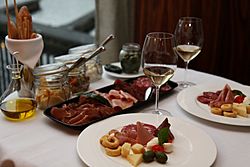Antipasto facts for kids

Antipasti served in a restaurant
|
|
| Place of origin | Italy |
|---|---|
| Main ingredients | Any of cured meats, olives, peperoncini, mushrooms, anchovies, artichoke hearts, cheese, pickled meats and vegetables (in oil or vinegar) |
| Variations | Seafood platter; calamari, mussels, smoked salmon, tuna fish, olives. |

Antipasto (say "an-tee-PAH-stoh") is a special first course in a traditional Italian meal. The word "antipasto" means "before the meal" in Italian.
It's usually made of small, bite-sized pieces. These are often served on a big plate, and everyone helps themselves. The main idea of antipasto is to make you hungry for the delicious food coming next!
Common things you might find in an antipasto include:
- Cured meats: These are meats like salami that have been specially prepared to last a long time.
- Olives: Small, tasty fruits often used in Mediterranean cooking.
- Peperoncini: These are small, spicy chili peppers.
- Mushrooms: Different kinds of edible fungi.
- Anchovies: Small, salty fish.
- Artichoke hearts: The tender middle part of an artichoke plant.
- Cheeses: Many types, like provolone or mozzarella.
- Pickled vegetables: Vegetables preserved in oil or vinegar, like pickles.
Contents
Regional Antipasto Styles
What's in an antipasto can be very different depending on where you are in Italy. Each region has its own special foods and traditions.
Southern Italy's Flavors
In the south of Italy, you'll often find:
- Different kinds of saltwater fish.
- Traditional cured meats, like soppressata or 'nduja (a spicy sausage).
Northern Italy's Delights
In northern Italy, it's common to serve:
- Many kinds of cured meats.
- Mushrooms.
- Near lakes, you might find dishes made with freshwater fish.
Cheeses Across Italy
The types of cheeses used also change a lot from region to region. You can find both hard and soft cheeses, each with its own unique taste.
Antipasto vs. Appetizers
Many people compare antipasto to hors d'oeuvres. While both are small dishes served before the main meal, there's a key difference:
- Antipasto is served right at the table. It marks the official start of the Italian meal.
- Hors d'oeuvres are often served away from the table, like at a party, before everyone sits down to eat.
You might also hear antipasto called a "starter" or simply an "appetizer."
See also
 In Spanish: Antipasto para niños
In Spanish: Antipasto para niños

